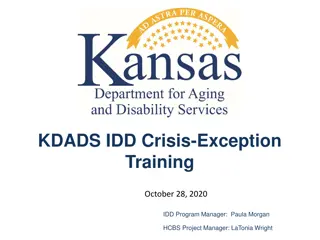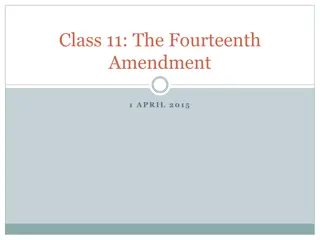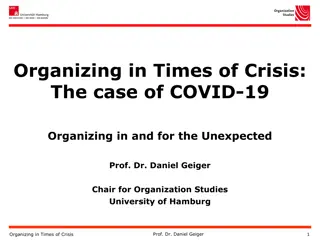The Late Middle Ages: Crisis and Disintegration in the Fourteenth Century
The fourteenth century in Europe was marked by the devastating impact of the Black Death, economic dislocation, social upheaval, and political instability. The bubonic plague wiped out a significant portion of the population, leading to labor shortages and peasant uprisings. The decline of the papacy's authority, the struggles of European states, and developments in literature and art also characterized this turbulent period.
Download Presentation

Please find below an Image/Link to download the presentation.
The content on the website is provided AS IS for your information and personal use only. It may not be sold, licensed, or shared on other websites without obtaining consent from the author.If you encounter any issues during the download, it is possible that the publisher has removed the file from their server.
You are allowed to download the files provided on this website for personal or commercial use, subject to the condition that they are used lawfully. All files are the property of their respective owners.
The content on the website is provided AS IS for your information and personal use only. It may not be sold, licensed, or shared on other websites without obtaining consent from the author.
E N D
Presentation Transcript
Chapter 11 The Late Middle Ages: Crisis and Disintegration in the Fourteenth Century
Focus Questions What impact did the Black Death have on the society and economy of Europe? What major problems did European states face in the fourteenth century? How and why did the authority and prestige of the papacy decline in the fourteenth century? What were the major developments in literature and art in the fourteenth century? How did the adversities of the fourteenth century affect urban life and medical practices?
A Time of Troubles: Black Death and Social Crisis Famine and Population Little Ice Age The Great Famine (1315 1317) Population outstripping resources by 1300 The Black Death: From Asia to Europe Role of the Mongols Eurasian landmass under single rule Spread of plague along trade routes
The Black Death in Europe Impact, Symptoms, and Spread of Plague Most devastating natural disaster in European history Bubonic Rats and fleas Pneumonic Arrived in Europe in 1347 Mortality reached 50 60 percent in some areas Wiped out between 25 50 percent of European population (19 38 million dead in four years) Plague returns in 1361 1362 and 1369
Life and Death: Reactions to the Plague Attempts at Explanation Plague as a punishment from God The flagellants Attacks against Jews Violence and Preoccupation with Death Art and the Black Death Ars moriendi, the art of dying
Economic Dislocation and Social Upheaval Noble Landlords and Peasants Labor shortage + falling prices for agricultural products = drop in aristocratic incomes Statute of Laborers (1351) : limit wages Social mobility Peasant Revolt in France Jacquerie (1358) An English Peasant Revolt (1381) Revolts in the Cities Ciompi revolt in Florence (1378)
War and Political Instability (Slide 1 of 2) Causes of the Hundred Years War The English king as vassal to the French king Disputed succession to the French crown The claims of Edward III of England Immediate cause: French attack on English Gascony (1337)
War and Political Instability (Slide 2 of 2) Conduct and Course of the War Significance of the longbow Early phases of the war The Battles of Cr cy (1346) and Poitiers (1356) Intermittent war and truce Renewal of the war Henry V (1413 1422) The Battle of Agincourt (1415) Charles the dauphin (heir to the French throne) Joan of Arc (1412 1431) Siege of Orl ans Captured by allies of the English in 1430 Burned at the stake (1431) The end of the war: French victory (1453)
CHRONOLOGY The Hundred Years' War Outbreak of hostilities 1337 Battle of Cr cy 1346 Battle of Poitiers 1356 Peace of Br tigny 1359 Death of Edward III 1377 Twenty-year truce declared 1396 Henry V (1413 1422) renews the war 1415 Battle of Agincourt 1415 Treaty of Troyes 1420 French recovery under Joan of Arc 1429 1431 End of the war 1453
Political Instability The Breakdown of Feudal Institutions Scutage New Royal Dynasties Financial Problems Parliaments gain power
Western Europe: England and France The Growth of England s Political Institutions Edward III (1327 1377) Parliament House of Lords House of Commons Aristocratic factionalism The Problems of the French Kings Basic lack of unity and financial troubles Civil war Burgundy and Orl ans
Germany & Italy The German Monarchy Breakup of the Holy Roman Empire Hundreds of states Electoral nature of the German monarchy The Golden Bull (1356) Weak kings The States of Italy Lack of centralized authority Republicanism to tyranny Duchy of Milan Republic of Florence Republic of Venice
CHRONOLOGY The States of Western and Central Europe: England People Dates Edward III Richard II Henry IV 1327 1377 1377 1399 1399 1413 p316
CHRONOLOGY The States of Western and Central Europe: France People Dates Philip IV John II Capture at Poitiers Charles V Charles VI 1328 1350 1350 1364 1356 1364 1380 1380 1422
CHRONOLOGY The States of Western and Central Europe: German Monarchy People Dates Golden Bull 1356
CHRONOLOGY The States of Western and Central Europe: Italy People Dates Florence Ordinances of Justice Venice Closing of Great Council Milan Visconti establish themselves as rulers of Milan 1293 1297 1322
The Decline of the Church Boniface VIII (1294 1303) and the Conflict with the State Conflict with Philip IV of France Unam Sanctam (1302) Captured by French at Anagni Clement V (1305 1314) The Papacy at Avignon (1305 1377) Decline in papal prestige Babylonian Captivity Supposed captives of the French monarchy Turning point in church history; specialized bureaucracy New sources of revenue Catherine of Siena (c. 1347 1380)
The Great Schism (1378-1417) The Papacy s Return to Rome (1378) Rival popes elected Pope Urban VI and Pope Clement VII The Great Schism Divides Europe France, Spain, Scotland and southern Italy supported Clement England, Germany, Scandinavia and most of Italy supported Urban Impact Heightened financial abuses Damage to the faith of believers
New Thoughts on Church and State and the Rise of Conciliarism Marsiglio of Padua (c. 1270 1342) Defender of the Peace Questions of authority The Conciliar Movement Council of Pisa (1409) Deposed both popes and elected a new pope Popes refuse to step down Results in three popes Council of Constance (1414 1418) End of the Schism Pope Martin V (1417 1431)
CHRONOLOGY The Decline of the Church Event Dates Pope Boniface VII Unam Sanctam Papacy at Avignon Pope Gregory XI returns to Rome Great Schism begins Pope Urban VI Failure of Council of Pisa to end schism; election of Alexander V Council of Constance End of schism; election of Martin V 1294 1303 1302 1305 1377 1377 1378 1378 1389 1409 1414 1418 1417 p319
Religion in an Age of Adversity The Variety of Responses to Crisis New trends concerning salvation Good works and charitable bequests Purgatory Popular Religion in an Age of Adversity Mysticism and lay piety Meister Eckhart (1260 1327) Modern Devotion Founder, Gerard Groote (1340 1384) Unique female mystical experiences Changes in Theology William of Occam (1285 1329)
The Cultural World of the Fourteenth Century The Development of Vernacular Literature Dante Alighieri (1265 1321) The Divine Comedy (1313 1321) Francesco Petarca (Petrarch, 1304 1374) Sonnets Giovanni Boccaccio (1313 1375) Decameron Geoffrey Chaucer (c. 1340 1400) The Canterbury Tales Christine de Pizan (c. 1364 1400) The Book of the City of Ladies (1404) A New Art: Giotto (1266 1337)
Society in an Age of Adversity Changes in Urban Life Family life and gender roles in late medieval cities Medieval children New Directions in Medicine Classical Greek theory of the four humors Physicians; surgeons; midwives, barber-surgeons; apothecaries Growth of medical textbooks In aftermath of the plague, new attention to public health and sanitation Inventions and New Patterns The clock: new conception of time Eyeglasses and paper Gunpowder and cannon
Discussion Questions What impact did the Black Death have on medieval European society? What were the causes of the Hundred Years War? What were the results of the war? Who was Joan of Arc, and what role did she play in the Hundred Years War? Why did the stay at Avignon lead to a decline in papal prestige? How was the Great Schism finally ended? How did Dante, Chaucer, and Christine de Pisan reflect the values of their respective societies? What were some of the technical advances invented during this time period?























